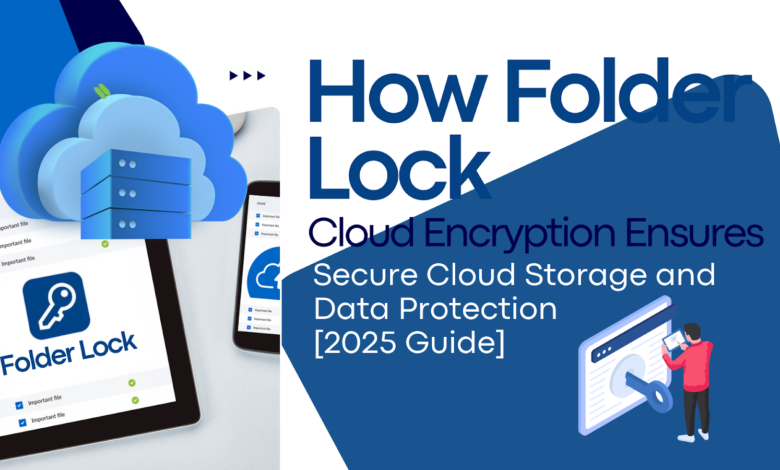How Folder Lock Cloud Encryption Ensures Secure Cloud Storage and Data Protection [2025 Guide]

Fast, working answers first (for busy readers) : How Folder Lock Cloud Encryption Ensures Secure Cloud Storage and Data Protection.
- How Folder Lock cloud encryption secures your data: Folder Lock creates encrypted “lockers” (AES 256) that live locally and inside your Google Drive/Dropbox/OneDrive accounts. Anything you put in those lockers is encrypted before sync, so the cloud only ever sees ciphertext. Open/close lockers from Folder Lock; files are readable only when you decrypt/unlock.
- Permanently remove Folder Lock encryption from files/folders: Decrypt (unlock) the locker from Folder Lock, move files out to a normal folder, then re encrypt or leave them in plaintext. If you used “Lock (hide)” instead of encrypt, simply Unprotect/Unlock in Folder Lock. (Never try to “bypass”—you’ll corrupt data.)
- Create a self decrypting file: Three working options: (1) Folder Lock Portable Locker for USB/share (recipient needs Folder Lock) (2) Make a password protected SFX archive with 7 Zip/WinRAR (cross platform extractors) (3) PGP “Self Decrypting Archive” (SDA) for Windows recipients. Note: some tools removed “EXE SFX” in newer versions; check your tool’s current capability.
- How quickly can a hacker crack your password? 2025 data shows massive speed ups with modern GPUs. Short/simple passwords can fall in minutes/hours; 12+ character mixed case+numbers+symbols can take decades to millennia (offline cracking). Always use unique, long passphrases and a manager.
- Are modified APKs like “Instagram Pro” safe? High risk. Sideloaded APKs bypass Google Play Protect vetting; they can hide trackers/malware and leak credentials. Stick to Play Store builds.
- Is 128 bit encryption secure? Yes. NIST says AES 128, AES 192, and AES 256 are all acceptable; 128 bit symmetric security remains strong for most use cases. For long term/high impact data, prefer AES 256.
- Choose the right encryption algorithm: For files/cloud, use AES GCM (or Folder Lock’s AES 256 lockers). For transit, use TLS 1.2+ (AES GCM/ChaCha20 Poly1305). For key exchange, use ECDH (P 256+). Follow NIST key management guidance.
- HIPAA and encryption (quick reality): HIPAA requires you to protect ePHI and to implement strong controls; encryption is a core safeguard used industry wide and typically expected in risk assessments and BAAs. Use strong crypto, sound key management, device+transit encryption, and document your risk analysis. (Consult counsel for program specifics.)
- Decrypt an Excel file (legitimate): If you know the password, open it and remove protection via File > Info > Protect Workbook > “Encrypt with Password” (clear the password). If you don’t know it, there’s no supported recovery—don’t attempt bypasses.
- Decrypt files encrypted with Folder Lock (legitimate): Open Folder Lock, log in, Decrypt the relevant Locker (e.g., Desktop/Google Drive/Dropbox/OneDrive), open the virtual drive, and copy files out.
- Encrypt data on Android/iOS (2024+): Both platforms encrypt by default once you set a strong screen lock; iOS “Data Protection” (AES 256) and Android file based encryption are on. Turn on Advanced Data Protection for iCloud for E2E cloud encryption.
- Encrypt files in Google Drive (2025): Either (a) use Google Workspace Client Side Encryption (admin managed) or (b) encrypt before upload (e.g., Folder Lock’s Google Drive Locker or an encrypted archive).
- Encrypt your backup hard disk: Windows: BitLocker. macOS: FileVault. Linux: LUKS. Encrypt before storing data and keep recovery keys offline.
- Secure PDFs with a password (2025): Use Adobe Acrobat: Protect > Encrypt > Encrypt with Password (AES 256), set open permissions.
- Secure remote work with encryption: Device encryption (BitLocker/FileVault), E2E collaboration, encrypted DNS/VPN, and hardened key management aligned to NIST.
Official Folder Lock Developer site : https://www.newsoftwares.net/
Deep dive guide (step by step tutorials + troubleshooting)
1) Folder Lock cloud encryption: secure by design, simple in practice
Why it’s safe: Folder Lock builds encrypted lockers using AES 256 and syncs only ciphertext to Google Drive/Dropbox/OneDrive. Your provider stores scrambled data; decryption happens locally when you unlock. You can also use a local “Desktop Locker” with on the fly encryption, plus shredding, history cleaning, and protected folders.
Set up a cloud encrypted workflow (Google Drive example):
- Install Folder Lock and sign in. From Home, you’ll see “Google Drive Locker,” “Dropbox Locker,” and “OneDrive Locker.”
- Click Install (if not configured), authorize the cloud account, then Open the locker. Anything you drop here gets encrypted and synced.
- When you’re done, click Encrypt (or close/decrypt the locker) to hide it from File Explorer again.
Open/close a Drive Locker later: Home > Google Drive Locker > Open (to view) or Encrypt (to secure).
Encrypt locally (Desktop Locker):
- Open Folder Lock, log in.
- Use Desktop Locker (Z:) that appears as a virtual drive; drag files in to encrypt instantly.
- Click Encrypt on the Desktop Locker tile to hide it. Click Decrypt to reveal it.
Share securely with teammates or clients:
- Use Portable Lockers for USB/email hand offs (recipient unlocks with their password using Folder Lock).
- Use your cloud locker and share with authorized users your team designates (Folder Lock implements a public/private key model for selective access).
Troubleshooting
- Cloud locker won’t open: Confirm you’re signed in to the right cloud account and the desktop sync app is running; then retry Open from Folder Lock’s Home screen.
- Drive letter conflict: If Z: is taken, Folder Lock assigns another letter—look for “Desktop Locker” in Explorer, not just Z:.
- Files not syncing: Place them inside the cloud locker root (not a look alike folder). Verify the cloud client is syncing.
2) Permanently remove Folder Lock encryption (safely)
Goal: Return files to plaintext without losing data.
Method A — Locker decryption + copy out (recommended):
- Open Folder Lock, log in.
- On Desktop Locker or your Google/Dropbox/OneDrive Locker, click Decrypt/Open.
- In File Explorer, copy files out of the locker to a normal folder.
- When finished, close the locker (Encrypt/Lock) so it disappears again.
Method B — Unprotect (for Hidden/Locked items):
- If you used “Protect Folders/Drives” instead of encryption, go to Safeguard > Unprotect/Unlock to remove the lock state.
Do not attempt registry hacks or third party “unlockers.” You risk corruption. Use Folder Lock’s own decrypt/unprotect workflows.
Troubleshooting
- Forgot Folder Lock master password: Folder Lock cannot decrypt without the correct password—by design. (No backdoor.) Keep secure backups.
- Cloud locker stuck “busy”: Pause cloud sync momentarily, close the locker in Folder Lock, then reopen and move files out in smaller batches.
3) Create a self decrypting file (3 reliable ways)
“Self decrypting” means the recipient can open with minimal tooling. Understand the limits: some vendors removed “SFX EXE” in recent versions.
A) Folder Lock Portable Locker (USB friendly)
- In Folder Lock, create a Portable Locker and set its password.
- Copy the locker to USB or share storage. Recipient opens with Folder Lock on their system and their assigned password. (It’s not a one file EXE, but it’s simple and keeps strong AES.)
B) SFX archive (7 Zip/WinRAR)
- Select files > add to archive > choose AES 256 + Set password.
- Check Create SFX archive.
- Send the resulting .exe to Windows recipients. Share the password out of band.
C) PGP Self Decrypting Archive (SDA)
- Use a PGP suite that supports SDA to package files into a Windows EXE that prompts for passphrase on open. (Enterprises often use SDAs for one time deliveries.)
Important: Some products (e.g., AxCrypt v2) no longer create SFX EXE. If you rely on SFX, verify your tool supports it today.
Troubleshooting
- EXE blocked by mail gateways: Zip the EXE, or host it and share a link.
- macOS recipients: Prefer encrypted ZIP/7z (no EXE), or share a Folder Lock portable locker plus instructions.
4) Password cracking speed in 2025 (and what to do)
Modern GPU rigs (e.g., banks of RTX 5090s) cut brute force times dramatically. Hive Systems’ 2025 research shows:
- Short numeric 8 char passwords can fall astonishingly fast (minutes at scale).
- 8 lower case letters: weeks.
- 8 mixed letters+numbers: years.
- 8 with symbols: longer, but still not ideal.
- 12–16 complex chars: practical safety for consumer threats; enterprises should aim even higher and enforce managers + MFA.
Action plan
- Use a manager to generate 16+ character random passwords.
- Turn on MFA everywhere.
- Never reuse passwords.
- Prefer passphrases when you must remember (“planet cello river tunnel 97”).
5) Is 128 bit encryption “secure enough”?

- Yes for most needs. NIST allows AES 128/192/256 in approved modes. For long lived/high impact data or regulatory comfort, choose AES 256.
- EU research likewise: AES 128 near term; AES 256 long term.
Modes matter: Prefer GCM (or XChaCha20 Poly1305) over old CBC for authenticity and performance.
6) Pick the right encryption for your sensitive data (quick matrix)
| Need | Good default | Why |
| Local files/folders | AES 256 GCM (Folder Lock lockers) | Authenticated, fast, easy to use. |
| Cloud storage | Client side encryption before sync (Folder Lock cloud lockers) | Cloud sees only ciphertext; easy team access. |
| Email attachment (one time) | Encrypted ZIP/7z (AES 256) or PGP SDA | Recipient opens with a password/tool; cross platform. |
| Key exchange | ECDH P 256/P 384 | Standard, strong, efficient. |
| Transit | TLS 1.2+ (AES GCM/ChaCha20 Poly1305) | Authenticated, modern ciphers. |
7) Decrypt files encrypted with Folder Lock (your files, your password)
- Open Folder Lock > log in.
- For Desktop Locker, click Decrypt to mount the virtual drive; copy your files out.
- For Google Drive/Dropbox/OneDrive, click Open/Decrypt on the locker tile; copy files out. Close it when done
If the locker is on USB: Use Open Portable Locker in the app and enter the password. (Don’t trust third party “unlockers.”)
10) Encrypt data on Android and iOS
iOS
- Set a device passcode: this turns on Data Protection (AES 256) for device data.
- Turn on Advanced Data Protection for iCloud to get end to end encryption of backups, Photos, Notes, Drive, etc. (keep your recovery methods ready).
Android
- Modern Android uses file based encryption; set a strong screen lock (PIN/password) so keys are protected.
- For work phones (MDM), your company may also require encryption via Intune policy—follow your Company Portal prompts.
Troubleshooting
- iCloud locked after ADP: You must use a recovery contact or recovery key; Apple can’t help without your keys.
- Android SD card: Some vendors offer card encryption in Settings; if you move the card to another phone, expect it to be unreadable without the original keys.
11) Encrypt files in Google Drive (2025, two paths)
Path A — Google Workspace Client Side Encryption (CSE)
- For organizations: Admin enables CSE for Drive/Docs/Sheets/Slides; users encrypt content with customer managed keys before upload. (Ask IT to enable and give you the client.)
Path B — Bring your own encryption (works for everyone)
- Use Folder Lock’s Google Drive Locker. Place files inside; they sync as ciphertext to Drive. Share only with trusted recipients who have the right keys/access.
12) Encrypt your backup hard disk (Windows/macOS/Linux)
- Windows 10/11: BitLocker for internal/external drives. Save recovery key offline. (Pro/Enterprise have full BitLocker; Home can use Device Encryption on supported hardware.)
- macOS: FileVault (System Settings > Privacy & Security > FileVault). Store recovery key in a password manager.
- Linux: LUKS (during install or via cryptsetup).
- Bonus: Keep backups in an encrypted locker (Folder Lock) before sending to cloud.
13) Secure remote work with encryption (quick checklist)
- Device encryption: BitLocker/FileVault on every laptop; mobile devices locked and encrypted.
- Data at rest: Team uses Folder Lock lockers for sensitive files (local + cloud).
- Transit: TLS everywhere, VPN for admin access, and encrypted DNS where supported.
- Identity: Password manager + MFA; least privilege access.
- Key management: Follow NIST SP 800 57 basics: protected generation, storage, rotation, and recovery.
Why Folder Lock is the best all round fit here

- End to end simplicity: One tool to encrypt locally, on USB, and in cloud lockers (Drive/Dropbox/OneDrive). The cloud never sees your plaintext.
- On the fly workflow: The virtual drive (Desktop Locker) makes encryption feel like normal file work. Open to work; close to secure.
- Team ready sharing: Selective access to encrypted files; portable lockers for external collaborators.
- Privacy extras: Shredding, history clean up, protected folders—useful defense in depth on Windows endpoints.
- Performance and standards: AES 256 lockers align with NIST recommendations; cloud lockers ensure sync convenience without weakening crypto.
Download Folder Lock for Windows/Mac/Android/iOS: https://www.newsoftwares.net/folderlock/
Common problems & fixes
- “I closed the locker and files vanished!” They’re encrypted/hidden. Reopen Folder Lock and click Decrypt/Open for that locker.
- “Google Drive shows files but I can’t open them from the web.” That’s expected—Drive stores ciphertext. Open via Folder Lock’s Google Drive Locker on your PC.
- “Portable Locker won’t open on my client’s PC.” Ensure they have Folder Lock installed or send an encrypted ZIP/7z instead.
- “Excel password forgotten.” There’s no legitimate recovery for modern Office crypto—restore from backup.
- “Android/iPhone says encrypted, but MDM complains.” Confirm a strong screen lock and re check compliance in the Company Portal/MDM app.
Which method should I use?
| Scenario | Best method | Notes |
| Work in progress on Windows | Folder Lock Desktop Locker | Encrypts on the fly; closes to hide. |
| Sync to Drive/Dropbox/OneDrive securely | Folder Lock Cloud Locker | Cloud only sees ciphertext. |
| One time share to Windows only recipient | 7 Zip/WinRAR SFX or PGP SDA | Watch mail filters; share password out of band. |
| USB/offline share | Portable Locker | Recipient uses Folder Lock to open. |
| Long term archive | Encrypted locker + offline key backup | Follow NIST key management basics. |
Password guidance snapshot (2025)
| Password type | Time to crack (indicative) |
| 8 digits only | Minutes with multi GPU rigs |
| 8 lower case letters | Weeks |
| 8 mixed case + numbers | Years |
| 8 mixed + symbols | Tens of years |
| 12+ mixed + symbols | Decades to millennia (offline) |
Source: Hive Systems 2025 methodology using modern GPU estimates. Real risk depends on reuse/breaches/MFA.
Quick FAQs
- Does Folder Lock encrypt before or after syncing to cloud?
Before. Files are encrypted inside the locker on your machine; cloud providers only sync ciphertext. - Can I open my cloud encrypted files from a browser?
Not directly. Download and decrypt via Folder Lock or mount the locker on a trusted device. - What happens if I forget my Folder Lock password?
There’s no backdoor. Without your password, decryption isn’t possible. Keep recovery and offline backups. - Is AES 128 really safe?
Yes, per NIST. For long term/high impact data, choose AES 256. - What’s better for file encryption—CBC or GCM?
GCM. It provides confidentiality and integrity with better performance. - How do I safely share encryption keys/passwords?
Never in the same channel as the file. Use a different medium (e.g., call/SMS) or a password manager’s sharing feature; rotate after use. Follow NIST key management guidance. - Does iPhone automatically encrypt my data?
Setting a passcode turns on Data Protection (AES 256). Enable Advanced Data Protection to end to end encrypt more iCloud categories. - How do I remove encryption in Excel?
Open with the password, then clear it via File > Info > Protect Workbook > Encrypt with Password. - Can I make a single, self opening encrypted file?
Yes—use ZIP/7z SFX or PGP SDA for Windows recipients. Note AxCrypt v2 dropped SFX EXE. - Does Folder Lock work for remote teams?
Yes. Cloud lockers let teams collaborate on encrypted files; only authorized users can open. - What if my Drive Locker won’t show in Explorer?
Open Folder Lock and click Open/Decrypt for the Google Drive Locker (or check Program Preferences for the locker path).
Final, practical templates you can adopt today
Template A — Personal (Windows + Google Drive)
- Install Folder Lock. Create a Desktop Locker and a Google Drive Locker.
- Work inside Desktop Locker; move finished files into Drive Locker.
- Weekly: shred temp folders, clean history, and back up the locker to an external drive.
Template B — Team (Drive/OneDrive + password manager)
- Admin: provision Folder Lock for all Windows endpoints.
- Create a shared project locker (Drive/OneDrive). Share with project members.
- Enforce 16+ character passwords via your manager; MFA on all accounts.
- Quarterly: rotate keys/passwords, review access, and archive closed projects.
Template C — HIPAA minded shop (ePHI on Windows laptops)
- Device: BitLocker, MFA, MDM.
- Data: ePHI stored only in Folder Lock lockers; cloud lockers enabled only for authorized users with BAAs.
- Keys: follow NIST key management (protect/rotate/back up securely).
- Process: written risk analysis, incident response, audit logs.
